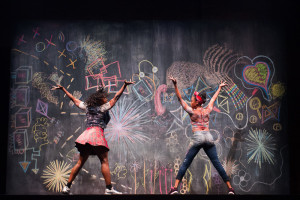“I see the street play, the tap dance; I see the double Dutch stuff. It tells a story about how girls pass on skills to girls. You don’t learn double Dutch from your teachers or your parents, but you learn it from your girlfriends. And it’s about that kind of sharing and that trust and that passing along of information and wisdom and ability and excellence.” – Eva Yaa Asantewaa

Sassafrass, Cypress & Indigo by Ntozake Shange (1982)
In talking about Camille A. Brown’s Black Girl: Linguistic Play—a show seeking to counter simplistic and overused portrayals of black female experiences in terms of strength and resilience by presenting black female experiences through nuanced understandings of play and protest, friendship and girlhood—Eva Yaa Asantewaa highlights the centrality of sharing to girlhood. I’ve included Brown’s work because it’s bewitchingly honest and glorious, and because I think it helps a great deal to connect mothering, the nature of black girl friendships, and ancestral inheritance—all themes that appear throughout Ntozake Shange’s Sassafrass, Cypress & Indigo.
Broadly, mothering is about nurturing, guiding, healing and cultivating gifts. While Aunt Haydee’s mothering manifests as teaching Indigo about “giving birth, curing women folks & their loved ones” and also making space for Indigo to play her fiddle, Indigo is seen mothering Aunt Haydee and others through storytelling (“Indigo told Aunt Haydee her own stories” 221), and soothing mothers and children with her fiddle. Not only are these acts reflections of motherhood, they also speak to the nature of friendship. You learn double dutch from your girlfriends. There’s a constant exchange between these women, these girls that ultimately conflates motherhood and friendship in a way that defines inter-generational communion.
“Aunt Haydee pleaded with Blue Sunday to ‘Please, give this child life, please, give this child the freedom you know.’ Then Indigo would play her fiddle, however the woman wanted” (223).
The above quote was extremely restorative and interesting in that although neither of these women//these girls are bearers of children; their participation alone in the process of bringing life into the world renders them mothers. Further, having the power to participate in the birth of people of color, and having the access to the history and thus the ability to call on ancestors for help is a gift. This moment where members of different generations (Blue Sunday, Aunt Haydee, Indigo, and the new child) come together becomes a recipe for ancestral inheritance. One that can look like playing double dutch, gaining the ability to move the sea, healing folks and their loved ones, and hands holding onto voices of slaves singing out of walls.
“The slaves who were ourselves had known terror intimately, confused sunrise with pain, & accepted indifference as kindness. Now they sang out from the walls, pulling Indigo toward them. Indigo ran her hands along the walls, to get the song, getta hold to the voices” (49).

Black Girl: Linguistic Play (Photo by Christoper Duggan). Found on camilleabrown.org



